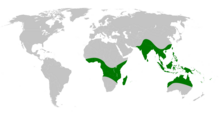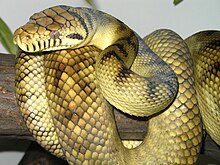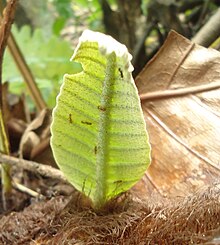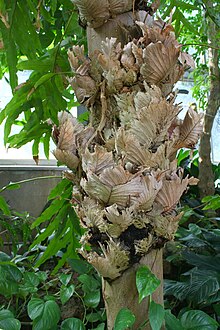Drynaria
| Basket ferns Temporal range: Piacenzian to Present | |
|---|---|
 | |
| Cultivated Drynaria rigidula in Florida | |
| Scientific classification | |
| Kingdom: | Plantae |
| Division: | Pteridophyta |
| Class: | Polypodiopsida/Pteridopsida (disputed) |
| Order: | Polypodiales |
| (unranked): | Eupolypods I |
| Family: | Polypodiaceae |
| Subfamily: | Polypodioideae |
| Tribe: | Drynarieae |
| Genus: | Drynaria (Bory) J. Sm.[1] |
| Species | |
See text | |
 | |
| Drynaria is widespread in the Old Worldtropics. | |
| Synonyms[2] | |
| |
Drynaria, commonly known as basket ferns, is a genus of ferns in the familyPolypodiaceae. It contains around 16 species and one natural hybrid.
Basket ferns are epiphytic or epipetric and are native to tropical Africa, South Asia, East Asia, Southeast Asia, Australia, and Oceania. Some species are economically important as medicinal plants.
Contents
[hide]Description[edit]
Basket ferns are characterized by the presence of two types of fronds, fertile foliage fronds and sterile nest fronds. The dark green foliage fronds are large, 2–4 feet (0.61–1.22 m) long, with elongated stalks. They are deeply lobed or pinnate, winged, and bearsori (structures producing and containing spores) on the bottom surfaces.[3]
The nest fronds are smaller rounded leaves basal to the foliage fronds. They do not bear sori and are persistent, not being shed after turning brown and dying.[3] They form a characteristic 'basket' that collect litter and organic debris, hence the common name.[4] The collected debris decompose into humus, providing the plants with nutrients it would otherwise not have received from being suspended above the ground.[5][6]
Both frond types grow from rhizomestypically anchored to a tree or a rock.[7][8] The rhizomes of Drynaria are creeping and densely covered in brown scales.[3]
Habitat and distribution[edit]
Basket ferns are epiphytic (growing on trees) or epipetric (growing on rocks). They can also sometimes be found in man-made structures like brick walls.[9] They are found in wet tropical environments, usually in rainforests.[4] Their native range extends from equatorial Africa to tropical South and East Asia, Southeast Asia, Australia, and Oceania.[10]
Life cycle[edit]
Like other spore-bearing plants, Drynaria exhibits metagenesis or the alternation of generations. One generation being the diploid multicellular sporophyte (the phase where the plant is most familiar), and the other being the haploid multicellulargametophyte (the phase where the plant is known as a prothallus). Gametophytes develop from spores released by mature sporophytes; while sporophytes, in turn, develop from the fusion of gametes produced by mature prothalli.[9][11]
Drynaria lends its name to a certain type of prothallial germination, the 'Drynariatype', observed in several other ferns. In this type, the spores germinate into a germ filament composed of barrel-shaped chlorophyllous cells with one or more rhizoids at the base cell. The tipmost cell divides repeatedly by cross-walls, forming a broad spatulate (spoon-shaped) prothallial plate. One of the cells at the top margin of the prothallus then divides obliquely when it has 5, 10, or more cells across its width. This results in an obconical meristematic cell. Division by this type of cell is parallel to each other and perpendicular to the rest of the cells, forming rows. This eventually results in the formation of a notch at the anterior edge of the prothallus, giving it a roughly heart-shaped appearance (cordate).[12]
The cordate prothallus are usually smaller with thinner midribs than that of other members of Polypodiaceae. They are also usually more sparsely haired, with some prothalli rarely having multicellular hair. They mature after six to nine months, and finish their life cycle at around a year. The gametophytes produce male (antheridium), and female (archegonium) gametes. The gametes fuse, forming the diploid sporophyte, the 'fern' part of the life cycle.[9][11][12]
Drynaria also naturally exhibits apospory, the production of a gametophyte not from spores, but directly from the vegetative cells of the sporophytes. Their leaves can develop prothalli under dim light and sporophytic buds in strong light.[13]
Ecology[edit]
Drynaria, like some other genera of ferns (including Polybotrya and Polypodium), possess specialized nectar-secreting structures (nectaries) on the bases of the frond lobes or the underside of the fronds. The produced nectar is rich in sugars andamino acids.[14]
Their function may be to attract ants (or other organisms) for protection or for sporedispersal. They may also be simply excretory organs (hydathodes), used for exuding surplus metabolic products.[14] The ant species Iridomyrmex cordatus is commonly associated with D. quercifolia, in addition to other epiphytic plants.[15]
In Australia, Drynaria rigidula serve as shelter for amethystine pythons (Morelia amethistina) and scrub pythons (Morelia kinghorni).[16] As much as 81% of sightings of the snakes in one study were in large individuals of D. rigidula located about 17–40 m (56–131 ft) above the ground. Snakes seek shelter in D. rigidula more frequently during the colder seasons.[17]
In the 19th century, Indigenous Australians were documented by the Norwegian explorer Carl Sofus Lumholtz to have hunted pythons regularly during the winter months by climbing up to individuals of D. rigidula.[18]
The large rhizome mass of Drynaria can also serve as growing substrates for other plants like the ribbon fern (Ophioglossum pendulum).[19] Due to their ability to preserve moisture and persistence even after death, the nest leaves ofDrynaria are also fertile hosts to a large number of water-borne fungi.[20]
Classification[edit]
Basket ferns are classified under the tribe Drynarieae, subfamily Polypodioideae, of the family Polypodiaceae. Species belonging to Drynaria were once classified under the genus Polypodium (rockcap ferns), under the subgenus Drynaria.[2][21]
Species[edit]
The following is the list of accepted species classified under the genus.[22] Species marked with † are extinct.
- Drynaria bonii H. Christ
- Native to India, Southeast Asia, and China. One of the smallest species of Drynaria, it can be distinguished by rounded nest fronds. The foliage fronds are pinnatesect with few widely separated lobes. The sori are arranged in two irregular rows between the secondary veins.[23]
- †Drynaria callispora Su, Zhou et Liu
- Extinct species from the Piacenzian age of China. See section below.
- Drynaria delavayi H. Christ
- Native to Tibet, China, Bhutan, and Myanmar. Nest fronds pinnatilobed with wavy margins. Foliage fronds are deeply pinnatifid, with 7 to 9 pinnae. Sori are large in comparison to the size of the lobes and arranged in two rows on both sides of the main rib and in between the secondary veins. Closely related to D. sinica.[24]
- Drynaria descensa Copel.
- Native to the Philippines. Similar to D. bonii but has smaller nest fronds, less than 2.5 cm (0.98 in) wide, with slightly scalloped margins. The foliage fronds are wavy.[23]
- Drynaria involuta Alderw.
- Drynaria laurentii (H. Christ) Hieron.
- Commonly known as ibandibandi.[27] It is native to equatorial Africa, fromCameroon to the Democratic Republic of the Congo.[28]
- Drynaria mollis Bedd.
- Drynaria parishii (Bedd.) Bedd.
- Drynaria propinqua (Wall. ex Mett.) Bedd.
- Native to Nepal, Bhutan, India, Southeast Asia, and China. A medium-sized species, it can be distinguished by deeply pinnatifid on both the foliage and nest fronds, with lobes that taper to a sharp point. The sori are arranged in two rows on each side of the primary rib of each lobe and in between the secondary veins.[3][23]
- Drynaria quercifolia (L.) J. Sm.
- Commonly known as the oak-leaf fern, pakpak lawin, gurar, koi hin, ashvakatri, or uphatkarul.[30] It is native to India, Southeast Asia, Malaysia, Indonesia, the Philippines, New Guinea, and Australia. It is a large species with deeply pinnatifid foliage fronds. The nest fronds resemble the leaves ofoaks, hence the common name. The sori are either scattered or arranged in two regular rows in between the secondary veins.[23]
- Drynaria rigidula (Sw.) Bedd.
- Commonly known simply as the basket fern. It is native to Southeast Asia, China, Malaysia, Indonesia, the Philippines, Australia, New Guinea, and the southeastern Pacific Islands. Easily recognizable by being the only species in the genus with 1-pinnate foliage fronds. The lobes are narrow, taper to a sharp point, and are narrowly-winged at their attachment to the rachis. Sori are arranged in two rows along the primary vein of each lobe. Includes the cultivar Drynaria rigidula 'Whitei'.[23]
- Drynaria roosii Nakaike
- Commonly known as Gu-Sui-Bu. It is native to East Asia. Sterile nest fronds are rounded shallowly-lobed reddish-brown fronds overlapping each other. The fertile fronds are larger and deeply lobed. They bear 1 to 3 sori arranged on both sides of the central rib.[8][31][32] Formerly known as Drynaria fortunei.[33]
- Drynaria sinica Diels
- Drynaria sparsisora (Desv.) T. Moore
- Commonly known as simbar layangan. Native to Southeast Asia, Malaysia, Indonesia, New Guinea, and Australia. A large species, it is similar to D. quercifolia but has smaller and stiffer foliage fronds. The sori are also smaller and arranged irregularly.[23]
- Drynaria volkensii Hieron.
- Native to tropical Africa including Cameroon, Rwanda, Kenya, Burundi, Tanzania, Sudan, Ethiopia, Somalia, Zambia,Malawi, and Mozambique. Nest fronds are pinnatifid with acute to obtuse narrow lobes. Foliage fronds are pinnatifid and deeply and narrowly lobed. Sori arranged close to the main rib, about 3 mm (0.12 in) apart.[36]
- Drynaria willdenowii (Bory) T. Moore
- Native to Mauritius and Madagascar.[37][38]
- Drynaria × dumicola Bostock
- A natural hybrid of D. sparsisora and D. rigidula[39] Found in Queensland, Australia.[40]
Traditional medicine[edit]
Extracts from the rhizomes of some Drynaria species are used extensively in traditional medicine.[41][42] In China, Taiwan,Vietnam, Thailand, and Laos, the rhizomes of Gu-Sui-Bu Drynaria roosii (more frequently cited by Asian authors by itssynonym Drynaria fortunei),[33] are commonly used to treat bone injuries.[9][43] Its common name literally means "mender of shattered bones" in Chinese.[44] Another species, the oak-leaf fern (Drynaria quercifolia) is used similarly in South Asia andMaritime Southeast Asia.[11][45]
Medical research[edit]
Numerous ethnopharmacological studies have been conducted into the properties of Drynaria.[9][11] In agreement with their use in traditional medicine, several studies have shown that basket ferns (D. roosii in particular) are effective in preventingresorption of bone cells and osteoporosis,[43][46] increases bone density, and have therapeutic effects on bone healing.[47][48][49] They have also been shown to possess a wide range of antimicrobial activity.[43][50][51]
Conservation[edit]
Species of Drynaria commonly used in traditional medicine like D. roosii and D. quercifolia are in danger of being overexploited. None of the species are currently cultivated for the alternative medicine industry.[9][11]
Drynaria are also considered endangered in some areas (like in New South Wales, Australia), due to threats of habitat lossand low population numbers.[11][52]
Evolution and fossil record[edit]
In 2010, twelve well-preserved fossil specimens of Drynaria were described from the Sanying Formation of the Yangjie coal mine of China. Named Drynaria callispora, it comes from the Piacenzian age of the Pliocene epoch (about 3.6 to 2.5 million years ago).[53]
The fossil record of Drynaria and drynarioids is not very well documented due to the typically poor preservation of fossilsrecovered. Previous fossil species assigned to Drynaria include Drynaria astrostigma, D. dura, and D. tumulosa from theCenomanian of the Czech Republic; and D. durum, all assigned tentatively to the genus in 1899. The arrangement and type of their sori, however, indicate that they are members of the family Matoniaceae instead.[53]
Outside the genus, Protodrynaria takhtajani from the Eocene-Oligocene boundary of Kursk Oblast, Russia shows some affinities to Drynaria but only distantly. The only other reasonably convincing fossil remains of drynarioids aside from D. callispora was a specimen named Polypodium quercifolia recovered in 1985 from the Late Miocene (23.03 to 5.332 million years ago) of Palembang, Indonesia. These were later transferred to the living species Aglaomorpha heraclea. It remains, as of 2011, the oldest known drynarioid.[38][53]
Below is a reconstruction of the evolution of species of Drynaria and closely related genera Aglaomorpha and Selligueabased on combined morphological and molecular phylogenetic data (Janssen & Schneider, 2005). Drynaria is likely to beparaphyletic, in contrast to Aglaomorpha, another genus which possess specialized humus-collecting structures.[54]
| ← |
| ||||||||||||||||||||||||||||||||||||||||||||||||||||||||||||||||||||||||||||||||||||||||||||||||||||||









No comments:
Post a Comment